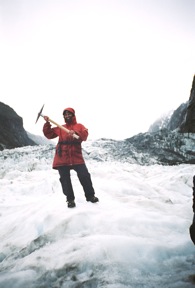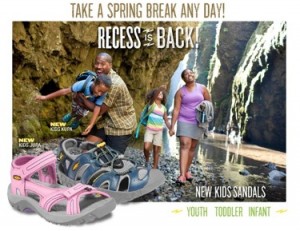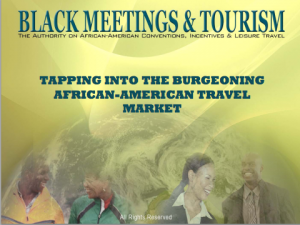Outdoor recreation in this country poorly reflects the racially diverse face of America and the world at large. There’s a racially significant divide between those who choose to recreate outdoors and those who do not. I call it The Adventure Gap. ~ James Mills

Written by Elaine Lee, Esq. in consultation with James Mills, creator of Joytripproject.com. Elaine is a freelance print, online and broadcast journalist as well as editor of the book “Go Girl: The Black Woman’s Book of Travel and Adventure.” Her cyberhomes are www.ugogurl.com and www.elaineleeattorney.com.
Looking at the people portrayed in most adventure travel literature today, most of the non-white faces you see are the indigenous people, local guides and servants featured there. Until now, the typical adventure traveler has been the 35 year-old white male, but increasingly women and people of color are exploring new and adventuresome ways to navigate and play on our planet, creating new travel patterns and a new travel market. Let’s look at some factors behind the seeming dearth of African American adventure travelers, forecast the future of diversity in the adventure travel industry and explore strategies for accessing and serving the African American travel market.
Ignored Demand: The Gap in Media and Advertising
African Americans spend an average of $40 billion dollars annually on travel, yet few articles, magazines, books and television shows currently feature African American adventure and international travelers. African Americans venturing out across the planet today still wonder where it is safe to go, how they will be received in various regions of the world, where will they feel welcomed and comfortable and which places offer amenities that will satisfy their unique interests.
"Why don't I see more African American travelers ???"
Travel for African American’s prior to, during and post slavery was often fraught with danger and complications.
Starting with the treacherous “middle passage” journey, millions of Africans died while being transported to the Americas. During slavery, African Americans were not allowed to travel without a pass from their owners. If they tried to run away they were often publicly tortured and/or maimed to serve as a disincentive to others who might consider fleeing.
During emancipation in the 1860’s until 1960’s African Americans in the south were subjected to Jim Crow and apartheid laws, and were not allowed to eat in most restaurants, stay in most motels, or use most public bathrooms and water fountains which made travel challenging to say the least.
As a result of this, the most common travel among African Americans was within the continental United States and was primarily utilitarian or familial in nature; e.g., seeking work or kinfolk and attending funerals and family reunions.
But over the past 10-20 years this historical “black travel” trend has changed steadily, as rapidly increasing numbers of African Americans embark on recreational, international, business and adventure travels.
Despite increasing equality in many aspects of American society, we see an apparent racial divide or “travel gap” between those who participate in outdoor recreational, adventure and international travel, and those who don’t.
Dr. Nina Roberts, a social scientist from San Francisco State University writes, “Factors such as perceived discrimination, socialization and upbringing, fear [for] personal safety…and/or lack of knowledge and awareness, are a few of the many reasons [African-Americans] provided for lack of visitation to outdoor environments.”
James Mills, a leading African American outdoor recreational journalist writes, “In the wilds of nature, without the safety of numbers and locked doors, people of color may feel more vulnerable. So they may simply opt to stay home, denying themselves and, potentially, future generations the opportunity to establish and enjoy a comfortable relationship with the outdoors. If more African Americans can remove the filters from their thinking that prevent them from crossing the adventure gap, a new generation of environmental stewards and explorers will, in time, reflect the increasing diversity of our nation.”
Shifting Markets
As more African Americans venture abroad, sports and adventure clubs are leading the way.
Consider:
- The National Brotherhood of Skiers Association’s (NBS) membership has grown from 12 clubs and 350 members in 1975, to 83 clubs and over 3,000 members in 2013. Their annual ski summit is the largest ski convention in America. The NBS clubs sponsor dozens of U.S. based trips each year, and are including an increasing number of international destinations, such as St. Moritz, France; Innsbruck, Austria; Whistler, Canada; and Mt. Fiji, Japan.
- The National Association of Black Scuba Divers (NABS) currently has 56 clubs and over 2,000 members, compared to 5 clubs and 138 members in 1991, the year it was founded. According to Co-founder Dr. Jose Jones, “Our annual summit is always overseas and it is the largest single group diving event held for U.S. divers. Our favorite site is Curacao. We recently had a club get back from Egypt, another from Australia and another from Tahiti.”
- The National Black Boater’s Association will hold its 16th annual sailing summit in the British Virgin Islands in August of 2013. NBBA founder Paul Mixon writes, “In just 16 years, we have watched our event grow from 1 boat and 8 sailors to 24 boats and 174 sailors, with 16 in our `land lubbers’ contingent."
As this trend continues, adventure travel tour operators, action sports shop owners and product manufacturers will need to discern the purchasing priorities and travel goals of a changing marketplace – one that acknowledges the emerging African American market. Gloria Herbert, co-founder and editor of Black Meetings & Tourism Magazine reports, “African-Americans constitute one of the country’s top three fastest-growing markets in all segments of the travel and tourism industry, including sports tourism, meetings, adventure travel, heritage and cultural tourism, religious retreats, romantic getaways, eco-tourism, wellness vacations and international travel. With a buying power estimated to reach $1.1 trillion by 2014, African-Americans account for 45 percent of the $90 billion in total revenues generated by multicultural travel.”

“Travel planners catering to African-Americans cite growing numbers. Of attendees surveyed at the Niagara Falls 2010 African American Travel Conference, which comprises more than 2,000 travel planners serving the African-American community, 89 percent said they were finding new travelers in their community and 62 percent said the average number of passengers per tour is 36 and up,” writes Salome Kilkenny of the Network Journal. According to Rue Mapp, creator of Outdoor Afro, and a KEEN product ambassador, “The company’s outreach to African-Americans gives them a market advantage. They’re actually starting off as a young company with diversity in mind and that’s going to position them for great success. With billions of dollars in purchasing power African-Americans form a vast base of new consumers who could significantly influence the outdoor industry.”
Another trend in the African American travel market is the steady increase in black travel literature. In 1997 when I published my book, “Go Girl: The Black Woman’s Book of Travel and Adventure,” there were no travel books geared to African Americans on the market. In 2013 there are at least thirty. In 1997 there were no African American print travel magazines, now there are three. In 2001 there were two national black travel websites. Today there are over forty.
Developing Market Access
 To learn more about the African American travel market, check out a prospectus created by Black Meetings & Tourism Magazine, “Tapping into the burgeoning African-American travel Market."
To learn more about the African American travel market, check out a prospectus created by Black Meetings & Tourism Magazine, “Tapping into the burgeoning African-American travel Market."
Here are several other strategies to consider to help understand and meet the needs of this segment:
- Develop presence by having an information booth at one of more of the largest African American national conventions or events, such as the NAACP, the National Urban League, the Congressional Black Caucus - where the average attendance hovers around 10,000 - or mega-events like the Essence Music Festival held in New Orleans, or the Indiana Black Expo, which draw as many as 100,000 attendees.
- Explore networking possibilities by attending a travel conference offered by groups that cater to African American travelers, e.g. Travel Professional of Color or African American Travel Conference
- Develop a relationship and discuss partnering with an existing travel company that has a large black clientele to create an adventure travel marketing campaign.
- Place ads in mainstream and/or travel African American magazines.
- Create familiarization trips for leading African American journalists.
- Work with a marketing company that specializes in accessing the African American market.
- Developing a relationship with one of the many environmental organizations that are working with minority youth to help them establish a relationship with the natural world, e.g., Sierra Club’s Inner City Outings Program which connects kids from city neighborhoods with the outdoor and works to build their skills as stewards of wilderness. See a complete list here.
In recognition of the growing sophistication of black travelers and the economic power of African-Americans with travel on their minds, it is important to take into consideration the not-so-secret secret: black people travel, too.
For examples of African American Travel Heroes and a timeline of key advancements in African American adventure travel, please click here to see more from author Elaine Lee.
